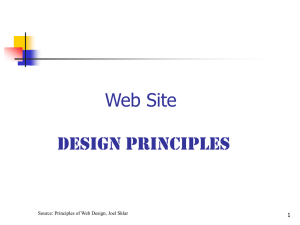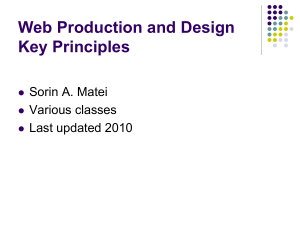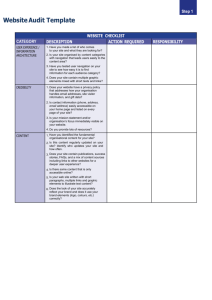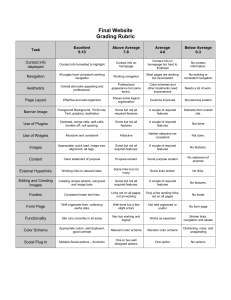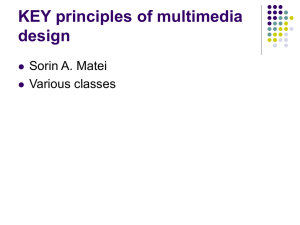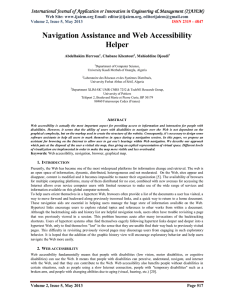Introduction to Web Page Design
advertisement
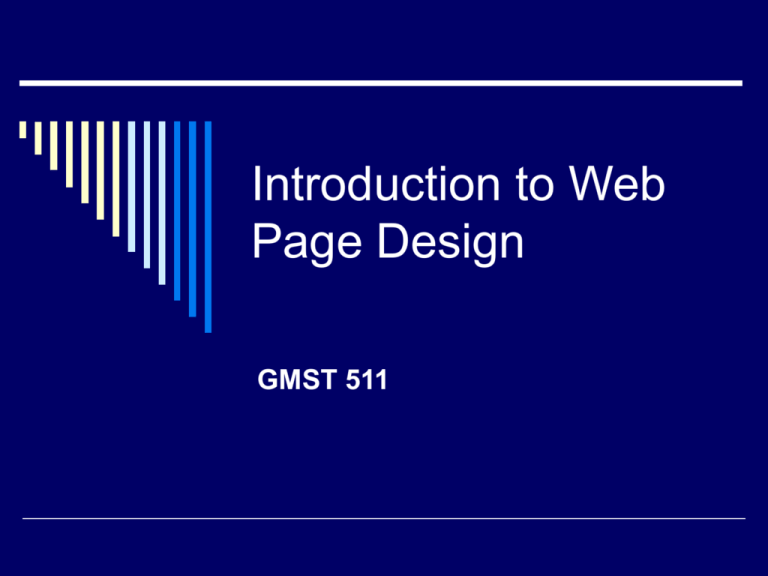
Introduction to Web Page Design GMST 511 Web Design Information Background on the web Terminology Web design principles Files on the web Some theoretical considerations Further advice In the beginning… The WWW used straight HTML (Hyper Text Markup Language). And it was good… A little plain, an absolute pain, and completely unformatted, but it was good. <html> <title> Kris Green's Home Page</title> <body bgcolor=#e47833> <img src="gifs/dragon.gif" align=left> <h1> Welcome to the Source of all Information! </h1> Well, information about me or information I find important, at least. I would first like to introduce myself, and then provide a brief overview of my home page, so that you'll know whether or not what you're looking for is here.<br> <br> <p>I'm currently in my fifth (and hopefully final) year graduate student at the University of Arizona, studying Applied Mathematics. My research interests center around large scale matter composed of tachyons as a cosmological source of structure. I also teach here in the math department, and if you're interested in some materials related to the course I'm currently teaching, follow the link above marked "Current Teaching".<p>Second, I enjoy martial arts. While I was an undergraduate at the University of Tennessee, I studied Isshinryu Karate under Bill Rader, a fourth generation student via Mr. Wheeler. I achieved the rank of First Kyu (or brown belt). </body> <hr> <address>Kris Green/<a href="http://www.math.arizona.edu"> Department of Mathematics</a> /<a href="http://www.arizona.edu">The University of Arizona</a> /last revised November 7, 1998</address> </html> And… You couldn’t just “post the web page”; you had to use FTP (File Transfer Protocol) to get it into place You had to type all the code into a text editor, then load it into the browser to view the results, then change the code, then reload, then… Plus, all the browsers did stuff differently Later… We got new features: Tables Frames Image maps CGI Scripting These gave users a way to control formatting, make navigation easier, and provide some interactivity (like forms...) Even later… We got WYSIWYG Interfaces (Frontpage and other packages)* We got Java, Javascript, XML, DHTML, CSS, Flash, Swish, Pop-up adds, P2P downloads… * Now called GUI (Graphical User Interfaces). Introduction to Terminology Pages -- Sites -- single HTML or HTM file consist of multiple pages (Hyper Text Markup) all information related to a single theme usually small (in physical file size) requires planning for layout integrates several different themes can be immense requires more careful planning for design and navigation What’s in a name (URLs) URL = Uniform Resource Locator Contains three parts: Protocol (http, ftp, etc.) Server name File name, including path http://keep2.sjfc.edu/faculty/green/default.htm Protocol for reading Server name – extension tells type of server File name and path* The Basics of Web Design Principles of graphic design for the web Navigation concepts for the web Organization of text on the web Links from one page to another Content and information Editing and maintaining Site design plans (graphical presentation) Principles of Graphical Design Keep the file size for the graphics small on the main page (use thumbnails with links to larger pictures, include file size information with link.)* Use colors from the “standard color palette” to reduce file sizes and increase flexibility. Keep backgrounds simple and not “busy”. Keep the viewable size of the page in mind so you can avoid scrolling as much as possible. * This is less important now with the large bandwidth Internet connections (RR and DSL). Site Navigation Principles Use a simple, consistent navigation interface. Organize the pages so that there is less need for many confusing navigation buttons. Remember, It’s the World Wide Web, NOT the World Wide Bowl of Spaghetti. Carefully plan the site organization FIRST. Site design should be based on function and content. Remember, “Three Clicks to Information”. Text Organization Principles Do not rely on spacing, tabs, or line breaks. Use tables (with border=0) to space the information on the page. Use horizontal lines to separate content, not for visual organization. Use headings (H1 through H6) rather than fonts and font sizes to organize information. Maintain a good, consistent visual hierarchy. Lists are good for organization. Links Provide the user with information about the link (title of site, file size and format, etc.) rather than just a URL. Don’t change the link colors, the followed link colors, or the basic text colors, if possible. People have learned to interpret the standard colors. Use a simple, consistent navigation throughout the site. Information (content) Include author information and contact information to the author and site manager. Focus the content of each page. Provide a list of links to other web sites that support or “fill out” your material. Vertical stratification of information is important to maintain consistency. Be concise and factual. Editing and Maintaining By all means, spell check! Frequently check active vs. dead links. Show, on the page, the date of the last modifications to the site/page. If you have to “take the site down” temporarily, provide an “under construction page” for the user with an estimated date of return. Plan a naming convention for files FIRST so that updating and maintaining is less of a hassle. Site Design Templates A1 A2 A3 B1 B2 B3 C1 C2 C3 Basic Grid Format D1 Home Page D2 D3 Hierarchical Format More Templates Sequential Web Layout Summary of Templates Complex Educated Audiences Simple Basic content, Training sites Linear narrative Predictable structure Nonlinear, hyperlinked Flexible, may be confusing Files on the Web HTML files = text document plus code Browser interprets code Code contained in tags (<h1> Stuff </h1>) Each image, sound, video, etc. is a separate file – all must be placed in location for access to outside world. However, images can be re-used. File Types on the Web IMAGES .gif, .jpg MOVIES SOUND FLASH MOVIE STYLE SHEETS DATA TEXT DOCUMENTS Other files others exist, but are not supported* .rm, .avi, .mpeg, .mov .wav, .mp3 .fla .swf .css .xml .doc, .pdf .xls, .ppt, etc. * Applies to most clip art (.wmf or anything). More about files Everything on your site must be in a publicly accessible folder – usually called public_html Folders and file organization are critical Paths to files are important Tree structure on the file server Relative or absolute paths Theoretical Considerations (Un)Intended consequences (see handout) Scenarios for online classrooms (taken from a presentation by Gerald Boerner at the Syllabus Conference, 2002) Effective web page elements for classroom support (taken from a presentation by G. Boerner at the Syllabus Conference, 2002) Scenarios Low-Tech traditional classroom Technology-supported classroom Web-aware hybrid classroom Web-supported classroom Web-based online classroom All material in this section is copyright Gerald Boerner (2000) and is used without express written permission. Effective Web Page Elements Further Advice Look to web sites that catch your attention for more hints. Check out Dave Siegel’s book Creating Killer Web Sites and his web site at www.killersites.com/core.html Try Web Style Guide by P. Lynch and S. Horton (available at SJFC Library).



